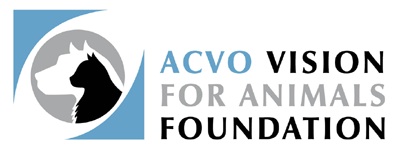What is canine glaucoma?
Canine glaucoma refers to a group of diseases that cause an increase in the pressure inside the eye (called the intraocular pressure or IOP). This increase in pressure damages the retina and the optic nerve and frequently leads to permanent blindness.
What causes a dog to get glaucoma?
Glaucoma can be classified as primary or secondary. Primary glaucoma develops because a dog is born with an abnormality in the part of the eye that drains the fluid from the eye. This part of the eye is named the iridocorneal angle and the fluid is called the aqueous humor. In most cases of primary glaucoma, the iridocorneal angle, which should be an open space crossed by thin beams of tissue, is replaced with a sheet of tissue with tiny “flow holes.” These small flow holes become obstructed as the dog ages; this prevents the aqueous humor from exiting the eye and the pressure inside the eye increases. In dogs, the pressure can increase very rapidly and can lead to permanent blindness in a matter of hours or days. Although there are some breeds of dogs that develop primary glaucoma more frequently than others, nearly all breeds, including mixed breeds, can be affected. If a dog develops primary glaucoma in one eye, it is likely to develop glaucoma in the other eye.
Secondary glaucoma develops secondary to another disease inside the eye. Some causes of secondary glaucoma include inflammation inside the eye (called uveitis), lens luxations, tumors inside the eye, blood inside the eye, chronic retinal detachments, and following intraocular surgery (e.g. cataract surgery).
What are the signs of glaucoma?
The typical signs of glaucoma include a cloudy or blue appearance to the cornea, increased redness in the “whites” of the eye, a dilated pupil, and vision loss. Some dogs will show signs of pain such as squinting or a decreased appetite. When glaucoma is chronic, the eye will become enlarged.
How is glaucoma treated?
Initially, glaucoma is typically treated with drops that lower the pressure inside the eye. Emergency treatment may also include intravenous or oral medications to lower the pressure. Unfortunately, the intraocular pressure will often increase over time, even with medical treatment. If vision is still present, surgical options to try to preserve vision can be pursued. These include the use of a laser to decrease the amount of aqueous humor that the eye produces or placing a shunt to facilitate drainage of the aqueous humor. In eyes that are blind, surgery is often recommended to relieve pain. These procedures can include removal of the eye (enucleation), creation of a “prosthetic eye,” or injection of a medication that decreases the production of aqueous humor. When a dog has primary glaucoma in one eye, the other eye is usually treated with drops to delay the onset of glaucoma. In cases of secondary glaucoma, drops are also typically used to lower the pressure while the underlying cause is addressed.
What is the prognosis for dogs with glaucoma?
Unfortunately, the prognosis for dogs affected by primary glaucoma is typically poor and many affected dogs will be blinded by the disease. In cases of secondary glaucoma, the prognosis may be better if the underlying cause can be promptly corrected. Glaucoma is a frustrating disease both for pet owners and veterinary ophthalmologists. The Vision for Animals Foundation is dedicated to advancing our understanding of canine glaucoma in hopes of providing innovative treatments for dogs that can preserve vision and eliminate pain.
VAF Funding Priorities – Canine Glaucoma
Experts in veterinary and medical ophthalmology gathered in November 2016 to formulate a plan to promote research on canine glaucomas, with an emphasis on improving surgical treatments. The following bullet-points summarize the Think Tank’s recommendations. These have been adopted by the VAF as high funding priorities.
- Dog- and breed-specific disease mechanisms and risk factors resulting in glaucomas are still poorly understood and need to be further investigated so they can be specifically targeted with more effective therapies.
- Novel diagnostic techniques for high-resolution imaging and functional assessment of the eye should be established for earlier glaucoma diagnosis.
- The discovery of genetic risk factors will allow the development of laboratory tests for identification of dogs predisposed to develop glaucoma before the onset of disease. These improved diagnostic tools will allow earlier, more effective therapy.
- Medical therapies need to be optimized for more effective control of IOP, surgery-related inflammation, and damaging formation of new blood vessels (neovascularization). Neuroprotective strategies should be developed to prevent degeneration of the retina and optic nerve regardless of IOP level. In addition to traditional drug administration, strategies must include intraocular implants for long-term drug release, gene therapies, and use of stem cells.
- Current surgical therapies consist of lasering the ciliary body (cyclodestruction) to decrease fluid production and placement of implants to increase fluid drainage from the eye. These methods may be performed separately or together and may be combined with cataract surgery. Additional techniques that have been developed for human glaucoma patients should be considered for use in dogs. These include micropulse laser and micro-invasive glaucoma surgery (MIGS).
The VAF has established a Canine Glaucoma Consortium to coordinate research efforts, review emerging discoveries, and update terminologies and classifications related to canine glaucomas.
A white paper, authored by invited participants in the ACVO Vision for Animal Foundation (VAF)’s Canine Glaucoma Think Tank (November 2017) and Canine Glaucoma Consortium, has been published in Veterinary Ophthalmology. The article, “The future of canine glaucoma therapy”, is published Open Access thanks to funding provided by the American College of Veterinary Ophthalmologists and the Veterinary Ophthalmology journal.

